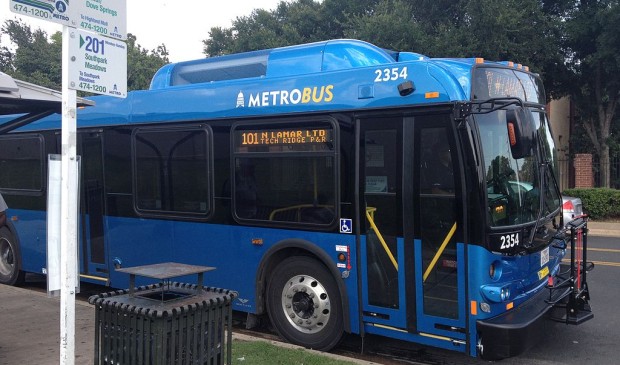CAMPO says buses should skip highway traffic
Monday, March 16, 2015 by
Tyler Whitson Most highway drivers resist the urge to cruise alongside a traffic jam on the route’s shoulder — it is illegal, not to mention rude. Some buses in Texas, however, may soon get a pass to jump the line.
The Capital Area Metropolitan Planning Organization Transportation Policy Board narrowly recommended Monday that the Texas Legislature pass a set of bills that would allow transit buses to use the shoulders of certain state highways during peak traffic periods, when the flow drops below 35 miles per hour.
Many state legislators are likely already familiar with Senate Bill 422 and House Bill 1432, filed by Sen. Kirk Watson (D-Austin) and Rep. Celia Israel (D-Austin), respectively. The Senate passed a similar bill in 2007, and both the House and the Senate passed comparable bills in 2009 and 2011. Gov. Rick Perry, however, struck down the legislation both times it hit his desk.
If passed, the law would create limited pilot programs in Bexar, El Paso, Tarrant and Travis counties that could spill over into adjacent counties in certain situations. In Travis, the testing grounds would be a southbound section of Interstate 35 and a northbound section of U.S. Highway 183.
The law would require that the Texas Department of Transportation initiate the pilot program before the end of the year and submit a report evaluating the pilot, making recommendations for changes and detailing a plan to turn it into a permanent program by the end of 2017. TxDOT would have the authority to cancel the program if it increases accidents.
Opposition at the CAMPO meeting stemmed primarily from safety concerns and a desire to vet the recommendation, which some board members complained they did not have a chance to consider thoroughly because staff added it to the agenda at the last minute.
Cedar Park Mayor Matt Powell was the dissenting board member who voiced this concern most loudly, though Williamson County Commissioner Cynthia Long, Lakeway Council Member Joe Bain, Georgetown Mayor Dale Ross and Burnet County Judge James Oakley also voted against the item. TxDOT Austin District Engineer Greg Malatek abstained.
“The first time that I’ve seen this information presented is when I sat down at the table here this evening,” Powell said. “This could be something potentially I could be supportive of with more time to vet it.”
Powell said the only evaluation that staff provided is a University of Texas study that supports the idea. “Accident histories of essentially all locations where (bus on shoulder) has been implemented indicate that the safety protocols used in Minnesota, California, Ohio, Florida and Virginia are adequate to ensure the safety of buses and other vehicles,” it reads.
“I’ve got a terrific study showing this is the safest thing in the world. I am sure that there is data supporting the other side,” Powell said. “I love the science on it and it’s wonderful, but I saw a movie once that said science can prove that an elephant can be dangled off the side of a cliff with its tail tied to a daisy. But you have to look at common sense.”
Todd Hemingson, Capital Metro’s vice president of strategic planning and development, attempted to quell Powell’s safety concerns.
Hemingson noted that TxDOT and Capital Metro would put several safety precautions into place. These include placing signage and restriping lanes, training bus operators and mounting a public education campaign. Buses would be limited to speeds no more than 15 miles per hour faster than traffic, or faster than the 35-miles-per-hour threshold.
“We believe the benefits of this are well-documented in at least 11 other cities throughout the country, and this is an extremely low-cost investment with a significant return on investment,” Hemingson added.
Board member and Travis County Commissioner Gerald Daugherty spoke out in support of the legislation. “I’ve vetted it, talked to a lot of folks, and I just think that it’s really a good bill,” he said. “I would love to see the ridership increase. … Anything that we can do that would allow people to get on the bus and more comfortably get on a repeated basis — I think that’s what we’re after.”
Oakley also voiced skepticism. “If I was on the outside lane driving along and I experience a blowout or some other unexpected mechanical failure, and I had to quickly get off into the emergency lane and I pulled right in front of a bus and hit it, who would be at fault?” he asked.
Hemingson responded that he did not know the answer to such a specific question and would look into it, but again pointed to the experiences of other locales. “If you look across the country at the national experience, the safety record has been very, very positive,” he said. “Very few incidents occurring in decades of experience, particularly in Minneapolis, Chicago and other areas.”
Both the Senate and the House have referred each of their bills to their respective transportation committees, though neither appears to have scheduled hearings.
Photo by Jsevse (I have taken this photo myself on my iPhone) [GFDL or CC BY-SA 3.0], via Wikimedia Commons
You're a community leader
And we’re honored you look to us for serious, in-depth news. You know a strong community needs local and dedicated watchdog reporting. We’re here for you and that won’t change. Now will you take the powerful next step and support our nonprofit news organization?



